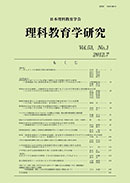Current issue
Displaying 1-18 of 18 articles from this issue
- |<
- <
- 1
- >
- >|
SPECIAL ISSUE: ACTION RESEARCH IN SCIENCE EDUCATION
Preface
-
2024 Volume 64 Issue 3 Pages 187
Published: March 31, 2024
Released on J-STAGE: March 31, 2024
Download PDF (547K)
Original Papers
-
2024 Volume 64 Issue 3 Pages 189-202
Published: March 31, 2024
Released on J-STAGE: March 31, 2024
Download PDF (3859K) -
2024 Volume 64 Issue 3 Pages 203-220
Published: March 31, 2024
Released on J-STAGE: March 31, 2024
Download PDF (1285K)
Original Papers
-
2024 Volume 64 Issue 3 Pages 221-235
Published: March 31, 2024
Released on J-STAGE: March 31, 2024
Download PDF (1068K) -
2024 Volume 64 Issue 3 Pages 237-248
Published: March 31, 2024
Released on J-STAGE: March 31, 2024
Download PDF (982K) -
2024 Volume 64 Issue 3 Pages 249-263
Published: March 31, 2024
Released on J-STAGE: March 31, 2024
Download PDF (4319K) -
2024 Volume 64 Issue 3 Pages 265-274
Published: March 31, 2024
Released on J-STAGE: March 31, 2024
Download PDF (2441K) -
2024 Volume 64 Issue 3 Pages 275-285
Published: March 31, 2024
Released on J-STAGE: March 31, 2024
Download PDF (1541K) -
2024 Volume 64 Issue 3 Pages 287-299
Published: March 31, 2024
Released on J-STAGE: March 31, 2024
Download PDF (1353K) -
2024 Volume 64 Issue 3 Pages 301-311
Published: March 31, 2024
Released on J-STAGE: March 31, 2024
Download PDF (2613K) -
2024 Volume 64 Issue 3 Pages 313-327
Published: March 31, 2024
Released on J-STAGE: March 31, 2024
Download PDF (2157K) -
2024 Volume 64 Issue 3 Pages 329-339
Published: March 31, 2024
Released on J-STAGE: March 31, 2024
Download PDF (1466K) -
2024 Volume 64 Issue 3 Pages 341-352
Published: March 31, 2024
Released on J-STAGE: March 31, 2024
Download PDF (2941K)
Notes
-
2024 Volume 64 Issue 3 Pages 353-364
Published: March 31, 2024
Released on J-STAGE: March 31, 2024
Download PDF (9417K) -
2024 Volume 64 Issue 3 Pages 365-373
Published: March 31, 2024
Released on J-STAGE: March 31, 2024
Download PDF (883K) -
2024 Volume 64 Issue 3 Pages 375-383
Published: March 31, 2024
Released on J-STAGE: March 31, 2024
Download PDF (2876K)
Report from the Editorial Board
-
2024 Volume 64 Issue 3 Pages 385-388
Published: March 31, 2024
Released on J-STAGE: March 31, 2024
Download PDF (682K)
Notice
-
2024 Volume 64 Issue 3 Pages 389
Published: March 31, 2024
Released on J-STAGE: March 31, 2024
Download PDF (518K)
- |<
- <
- 1
- >
- >|
